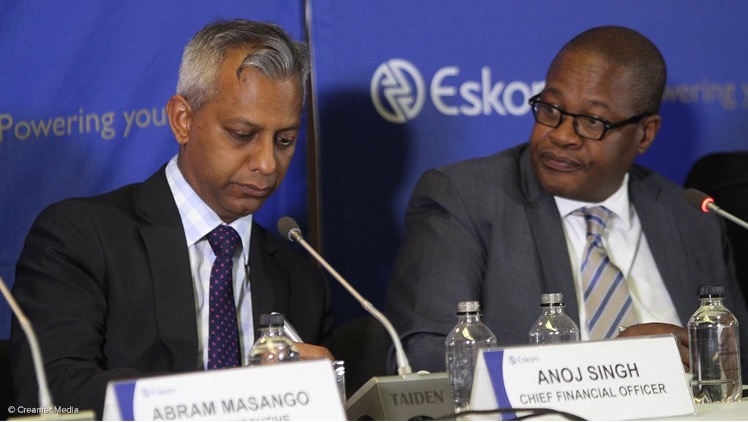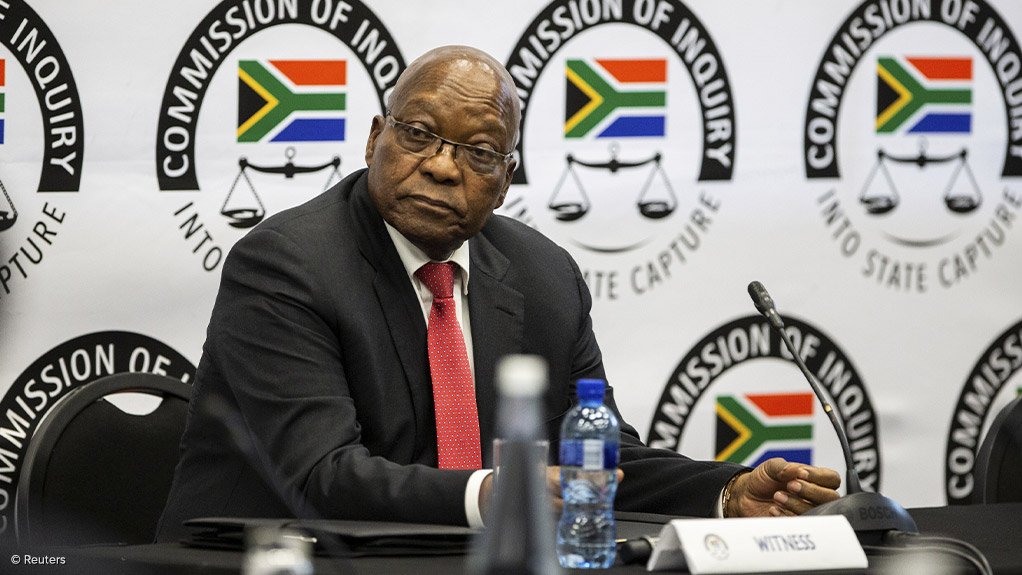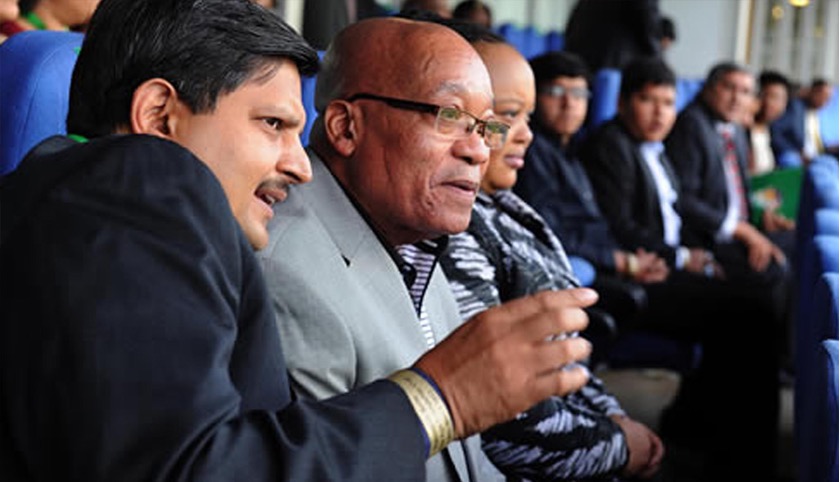By Eirini Tassi,
They say that as long as you live in a liberal democracy you shouldn’t worry; your state always ensures that every individual and every action remain within constitutional bounds. But who secures this constitutionality when the state mechanism, itself, becomes corrupted? This was a question that long troubled South Africans; as from 2010 to 2017, they watched their country become the personal playground of the Gupta business family. This powerful coalition latched itself onto the South African political apparatus and, like a parasite, slowly fed off its democratic foundations, until they were nothing more than ideas.
Of course, this neither occurred all at once, nor was it evident from the beginning. It was like termites: you first notice some unusual discoloring in your drywall but think nothing serious of it; you trust your house’s foundations and perhaps attribute the phenomenon to the season’s humidity. Yet as time passes, discoloring turns into ceiling cracks and squeaky floors, then into mud tubes, and before you know it, a termite dynasty is reproducing its heirs inside your ceiling.
“It’s just some discolored drywall”
The Guptas, originating from India, entered the South African economy in 1998, after successfully establishing the enterprise Sahara Computers. For some years, they remained (relatively) quiet. During a business event in 2001, they met future South African President, Jacob Zuma, who was serving as deputy President at the time, and this marked the beginning of their collaboration: Zuma’s family members began obtaining suspiciously high-ranked positions at several Gupta firms, and in return, Zuma protected their political interests via the state apparatus in ways and extents that were kept strictly behind closed doors. This was reinforced when he took over the presidency in 2009, as his position gave him higher institutional powers, such as veto capacity. While these ties had occasionally raised a few eyebrows, it was not until 2013 that the two parties’ affiliation was explicitly proven.
In what came to be called “Guptagate”, South African journalists revealed that Zuma had authorized an Indian commercial plane to land in South Africa’s Waterkloof Air Force base, for the purpose of transporting Indian passengers to a Gupta family wedding. This not only marked an abusive use of a military base, but also a violation of South African migration laws, as none of the passengers were entering the country with visas or other appropriate documentation. Rightfully so, both the press and the South African legislature raised concerns about Zuma’s abuse of presidential power and demanded both parties to take accountability for their action. And of course, they both did: Zuma’s cabinet members branded the plane landing as a “special” kind of an official visit, while the Guptas apologized, and justified the usage of the military base because the plane included Indian high ministers who were going to attend the wedding.
The two scripted apologies felt like a temporary solution. The South African legislature remained suspicious of the two parties, yet confident in the accountability mechanisms of the state. Like the confident house owner in the termite story, the wedding scandal was initially seen as some discolored drywall which could be effectively fixed if the country’s political watchmen kept an eye on both parties’ activities. However, reality was much more complex than that.
Squeaky floors
You see, the Guptas were not only interested in welcoming their Indian friends in military ground. They were interested in getting richer and more powerful. And that meant infiltrating into any South African policymaking institution that would ensure maximum interests for their enterprises, and of course, minimum interference by political democratic bodies. The 2010-2016 period saw significant changes in Zuma’s appointments of executive ministers, with those prioritizing the interests of South Africans rather than the Guptas immediately entering the blacklist.
Barbara Hogan, for instance, who was an experienced and well-governing minister of state enterprises, was replaced by Gupta-loyal Malusi Gigaba, who immediately sought to maximize the family’s financial benefits. This ministry was at the heart of the South African economy, being responsible for energy production, airlines, and freight rail. Gigaba thus appointed Gupta-loyals Brian Molefe and Anoj Singh as board members of the state rail company TRANSET, who in turn opened contracts of 450 million USD that benefited the Guptas’ business operations.

Most secretaries were, sooner or later, replaced by people loyal to the Guptas, while those who were not removed were urged to ally with them in exchange for financial rewards. Financial Minister Nhlanhla Nene, for instance, who refused to materialize a debt-inducing nuclear deal signed between Zuma and Putin, was immediately removed from his ministerial position. This comes to no surprise, as the Guptas were also involved in the uranium business, and thus largely benefited from a nuclear-power deal. Mcebisi Jonas was then offered high monetary rewards by Gupta family members to replace Nene and materialize their energy benefits, though he refused, and accused the family of “making a mockery” of the South African democracy. He was right. All these consecutive ministerial re-appointments by President Zuma had resulted in the political apparatus becoming a mere puppet of the Guptas’ energy and ICT interests. The state was captured.
The termite dynasty
With every year that passed, the state capture was growing. And journalists were aware of that. They knew that we were far past the “isolated discolored drywalls”, like the wedding scandal, and were now dealing with the Gupta dynasty, who had co-opted political actors in every state institution and had transformed them into allied parasites that fed off the South African public budget, policymaking, and democracy itself. Investigative press, like the Daily Maverick and the Sunday News, were systemically releasing articles about the Guptas and corrupted officials, which was challenging considering that a lot of information on Zuma’s re-appointments and ministerial co-optation was still highly gatekept.
But then, a sudden flow of information changed everything. In early 2017, human-rights lawyer Brian Currin got into his possession a hard drive from a personal Gupta computer, which explicitly showed all the fraud, money laundering, and ministerial intimidation they had committed in the past 7 years, as well as their classified communications with Jacob Zuma. The whistleblowers remain anonymous for their safety, yet, bravely managed to erase any doubts that the state capture was occurring.
But to be fair, everyone more or less knew that the termites were there. They had occasionally noticed both the discolored drywalls and the squeaky floors. Nobody believed that the Indian plane landed in the air-force base for an “official” political visit, nor that changing 4 ministers of finance in 4 months was normal. But what most people hadn’t realized was just how complex and interlinked this Gupta dynasty had become. At this point, even considerable judicial prosecutors worked for their business coalition and refused to prosecute Gupta-allied officials for fraud or infiltration with the public budget.
With this information in hand, investigative journalists began releasing various articles that disclosed the overall state capture, name-checking specific Gupta and Zuma family members, and specific political officials that supported them. Soon, such articles were reproduced by foreign media, with many, especially Western civil societies, pressuring the South African judiciary to punish the fraudulent businessmen and politicians. Was accountability finally arriving?

Disinfestation
The answer is yes and no. The Zondo commission was established in 2018 as a public tribunal to investigate the state capture and its perpetrators. There, in the guidance of non-corrupted Justices, numerous former ministers testified against the Guptas and Zuma, pointing to the intimidation they received by them throughout their terms. Politician Vytjie Mentor, notably, disclosed how she was offered a ministerial position by the Guptas in presence of Zuma, if she closed South Africa-India flights by South African airways, to benefit the Indian-based Jet Airways. Nene, who, as aforementioned, was fired for not materializing the Russian nuclear deal, revealed how he was systemically pressured by Zuma to accept it despite knowing the burden it would cause on the public budget. Zuma himself was also called to testify, though during his hearing before the commission, he claimed that he had no particular relation to the Guptas, and made an almost comic 20-minute monologue in which he stated that the state capture was nothing more than a conspiracy plot to remove him from power.

Needless to say, the national assembly didn’t buy it. He was pressured into voluntarily resigning from the presidency just a month after the Zondo commission was established, and the corruption investigations resumed under now President Cyril Ramaphosa. These did bring significant justice, with former TRANSNET board members arrested for infiltrating with the public budget under the Guptas’ instructions. Zuma’s son was also arrested on similar charges, while two of the Gupta brothers were arrested in Dubai in 2022 after fleeing South Africa during the corruption investigations. Even Zuma himself got charged with 15 months in prison for refusing to testify in specific instances in front of the Zondo Commission, though he ended up serving 2 months and was released on medical parole. The parasites were slowly unlatching.
For many, and especially investigative journalists, these developments were bittersweet. Ramaphosa’s rise to the presidency and the Zondo Commission undeniably restored institutional stability and justice within the country, but the stigmas of the state capture could not go away that easily for South Africans. Mistrust within the National Congress still remains high, and the aftermath of Zuma’s disintegrated coalition has left the Assembly somewhat polarized. Zuma himself has not really paid for his crimes of corruption and maladministration during the capture, as he was only charged for contempt of court during the Zondo testimonies, and barely served the 1/7th of his sentence. In the end, after living through the destructive termite dynasty, South Africans have learned to even be suspicious of the discolored drywalls. Will the disconnection between the government and the governed be in any way bridgeable?
References
- Deasy, R. and Kaplan, M. (2019). “How to steal a country”.
- “South Africa: Wealthy Gupta brothers arrested in UAE”. BBC.com. Available here
- Sarah Smit, StateCaptureInquiry: Mentor was too scared to meet with Zuma in China. Mg.co.za. Available here
- Former Transnet and Eskom execs Brian Molefe and Anoj Singh arrested on fraud charges. Businesstech.co.za. Available here




